The Generati on II Alaska 46 Sedan is an allround refinement of its predeccesor, the Alaska 46 Sedan and comes with enough changes to quantify its stat us as a second generation model.
Alaska Motor Yacht’s 46 (14m) Sedan was a popular boat with people looking for an easy-to-manage cruiser capable of accommodating four people in real comfort with the option of an extra two every now and then. Here Down Under we’ve been lucky too in that Alaska boats come with the familial warmth the Leigh-Smith family consider the proper way to do business with boats.
The very real benefits of this are of course never to be underestimated, nor is the input literally generations of experience on the water provides to customers who often seem to end up more friend than client… Boatbuilders too seem to flourish in association with the Leigh-Smith family and when it comes to a second generation of an already successful cruiser design, it’s no surprise to find astute refinement rather than dramatic change for change’s sake in this second generation of an already popular model.
Leigh-Smith Cruiser Sales’ Dean Leigh-Smith made no secret about his pride in their contribution to Gen II of the Alaska 46 Sedan.
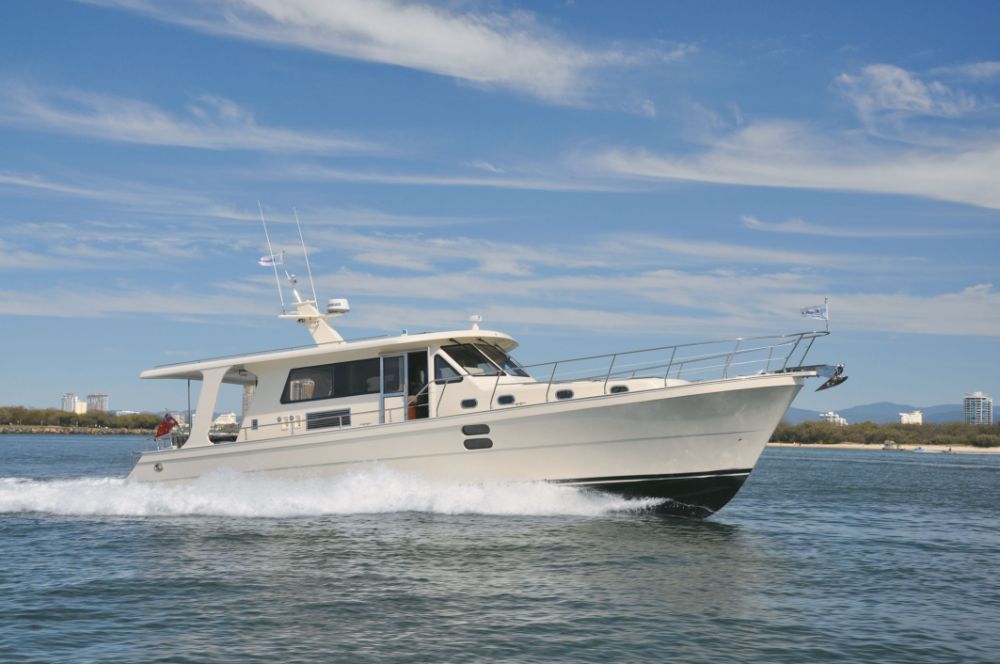
Downstairs
Perhaps the most significant development in this Generation II model to my mind is swapping the master and guest staterooms around. Instead of being in the bows, the master stateroom is now more or less amidships, while the bows accommodate two single bunks arranged one along each side. At once this makes both staterooms more space efficient and if the master stateroom commands a better situation for it – which it certainly does – it’s difficult to imagine those afforded the best bed in the house seeing any issues with that.
Stairs down from the saloon take you into a passageway along the port side. The master stateroom doors are now the sliding type which open wide to almost make a grand entrance showing off a queen size bed with two elongated portholes set centrally between a pair of wardrobes.
There’s lots of walking space around the bed, and a large mirror against the aft wall above the bed makes a room that’s anything but cramped seem even more spacious, the sense of space enhanced by a remarkable amount of headroom. I didn’t measure this, but would guess it to be close to the 2.4m standard ceiling height for buildings on land – as I said, remarkable for “downstairs” in a 46 foot trawler style cruiser.
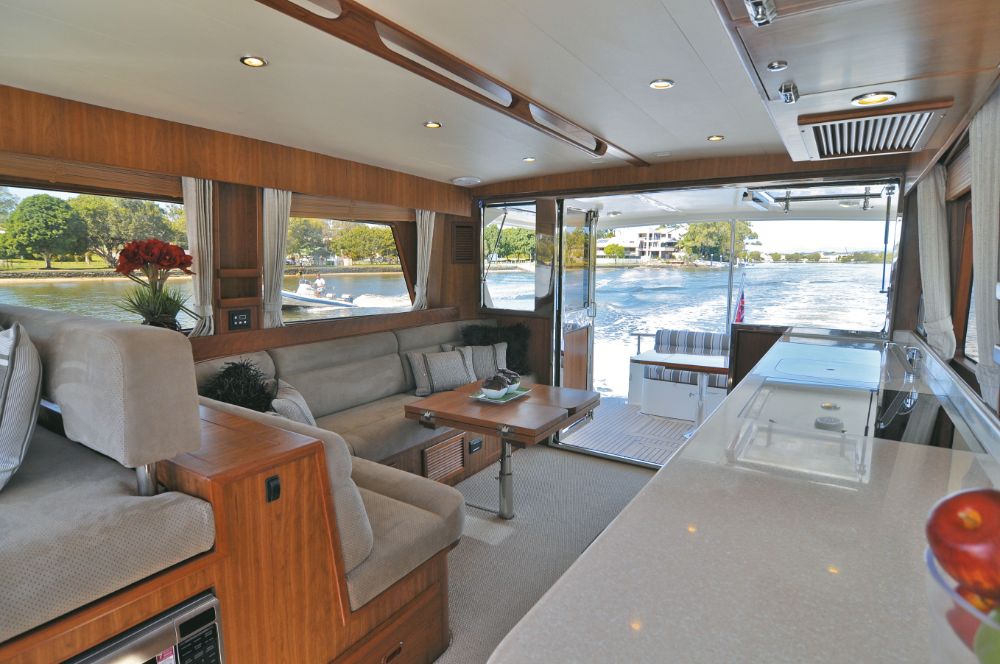
If you don’t wish to run the standard air conditioning, natural cross ventilation is available downstairs from hatches in the roof (with incorporated shade blinds and insect screens) and by opening the upper porthole in the stateroom and a corresponding one in the passageway. If the stateroom doors are closed, ventilation is maintained through timber slats in the doors.
The master stateroom has its own ensuite forward against the starboard side of the hull while the guest ensuite is opposite it to port, with access from the passageway. Those stairs leading down to the staterooms lift to reveal a stowage compartment tucked away aft beneath the saloon floor. This could be the place for a laundry – or just for extra stores.

The Saloon
Upstairs the saloon’s large windows again afford a sense of space almost disproportionate to a 14m boat. The galley stretches along the portside with the helm station and an L-shaped dinette lounge to starboard, separated by a wide central walkway. In typical trawler style the helm features a large diameter wheel set vertically against the bulkhead with the dash in an upholstered binnacle above it; and a bench helm seat and backrest matched to the dinette.
Leigh-Smith Cruiser Sales has a long-time association with local interior designer Identity Designs and the decor in the boat Pacific PowerBoat went aboard was certainly eye pleasing and made its own contribution to the boat’s appeal.
Chart lockers use up bench space beside the helm in a very practical way. All the electrical switching, etc., is set up behind smoked doors conveniently located beside the steering wheel. Vision from the helm all around the boat was excellent, thanks to large windows right around the saloon – provided of course their privacy blinds and curtains were all open at the time.
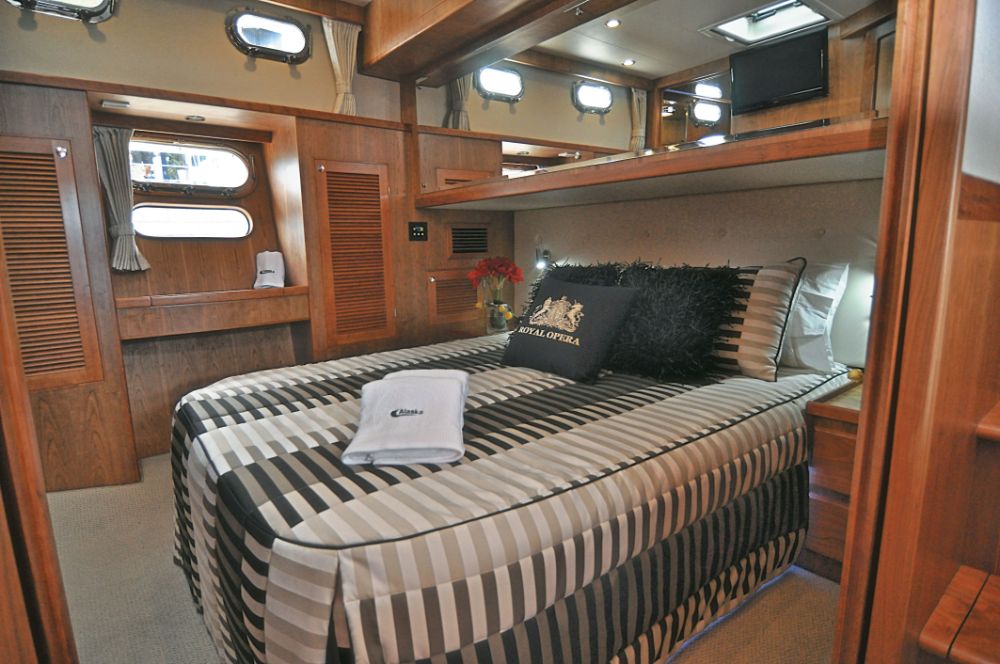
Vision forward through the tri-panel flat windscreen was a bit of a problem on the day because it was pouring rain. Who said Gold Coast weather is beautiful one day and perfect the next? Not me, I live here; although the inclemency certainly did highlight how well the wipers work.
Access from the helm down that central passageway or to sliding doors leading out to the side decks each side of the superstructure is sensibly free of obstructions to the rapid movement sometimes necessary. A timber handrail along the ceiling above the saloon’s passageway is there if needed; just one of many practical details found all over this boat.
Massive polished stainless steel brightwork around the side doors and aft cabin doors leaves no doubt about their integrity. Hopper windows opening the saloon and cockpit to each other are popular at present and the Alaska 46 Sedan’s bifold saloon door makes the opening quite substantial.

This, those roomy staterooms in their new configuration, and the general openness and spaciousness of the saloon all add together to make this boat’s liveaboard accommodation quite appealing and very favourably comparable with competitors.
Extra bunks are available in the saloon by lowering the multi-fold table, thus converting the dinette lounge; although most people would only do so occasionally I imagine. Six people could actually fit around the dining table with maybe just a little pinch.
Funnily enough the only awkward aspect to be found in the saloon layout was the flat screen TV which rose out of timber panelling between the helm station and the dinette. People sitting on the short part of the “L” would block the view from the long part, while having their backs to the TV.
Two fridge/freezers come standard in this boat as does a 4-ring electric cooktop and a microwave oven and drawer type dishwasher. The cooktop is a flush mounted domestic type without any provision to restrain pots and pans while cooking. An overhead locker above the galley bench has crockery racks in drop down doors in its lower surface.
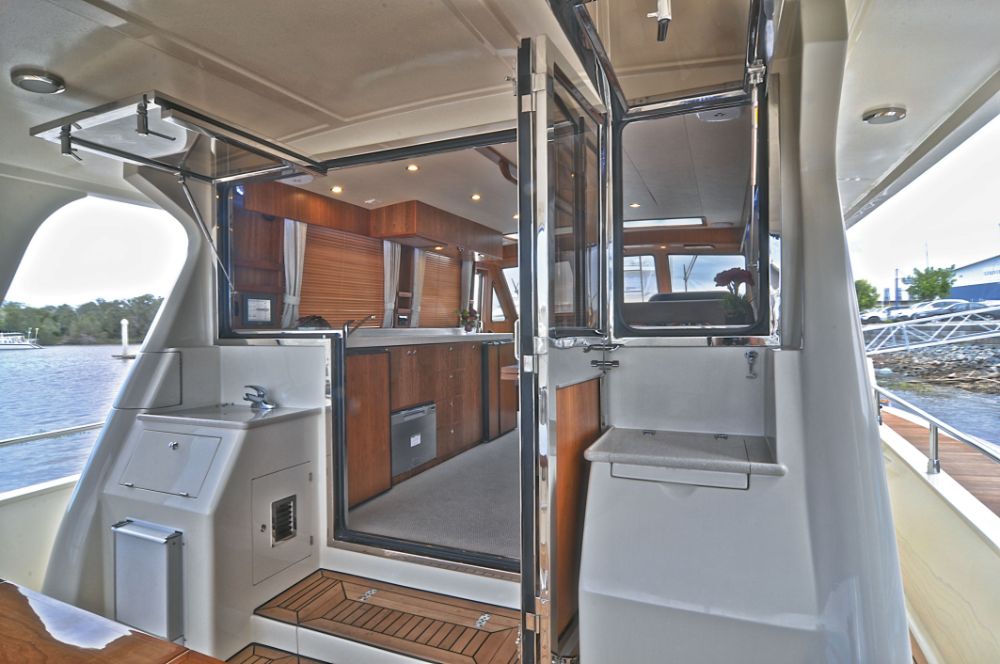
Having the galley (Corian) benchtop stretching right along the entire portside of the saloon from the side door to the aft bulkhead makes plenty of cupboard space available below – including the two side-by-side door fridge/freezers. All the interior is air conditioned with dual 4.7kW and 7.0kW Cruisair units servicing the staterooms and saloon supplied as standard fitment. Quality electrical equipment includes a Samsung LED TV, a Fisher and Paykel dishwasher, Novacool refrigeration and a Fusion sound system. Lighting is LED throughout with power supplied to the electrical systems on board by a 7kW Onan genset. BEP’s excellent C Zone system integrates and controls all the electricals from a monitor and control unit mounted above the galley benchtop aft beside the hopper window. 240V shore power connectivity and an appropriate lead are also standard inventory. Simrad NSS 12 inch touchscreen radar and GPS units are optional.
Outside
The Sedan model’s hardtop reaches all the way aft to the Alaska 46’s transom and all the way to the boat’s sides, very effectively shading the cockpit and the saloon windows.
Walking forward along the cabin sides is hassle free and the teak underfoot along the side decks and in the cockpit gives away to a moulded non slip deck as you step up onto the foredeck.
Moving along each side of the boat is also made secure with high rails providing something solid to hang on to as you make your way forward to the bows to handle the ground tackle and the anchor winch. Right at the bows, twin fairleads allow a second anchor to be stowed ready for use beside the 27kg plough supplied with the boat.
Aft in the cockpit a large hatch in the deck at the saloon doors accesses the engine room. This, it was a pleasure to find, is roomy enough for (albeit hunched over) easy access to the pair of Cummins QSB 5.9 litre 6 cylinder engines, with the Onan to port as you enter. I’ve been aboard a lot of 14m cruisers where even my scrawny frame was pushed to get around the engines for normal service. I noted while in the engine room that a large section of the saloon floor above could be unclipped and an engine lifted out through the saloon doors.
Behind the engine room hatch a second, smaller, hatch accesses a roomy stern lazarette. The air conditioners are located in here leaving plenty of room for stowing items, stores, etc., you don’t need immediately.
Against the transom the boat we were aboard had a table and seat over the lazarette. An icebox is standard below this seat although the space can be refrigerated as can a smaller ice box against the saloon bulkhead to starboard of the aft door.
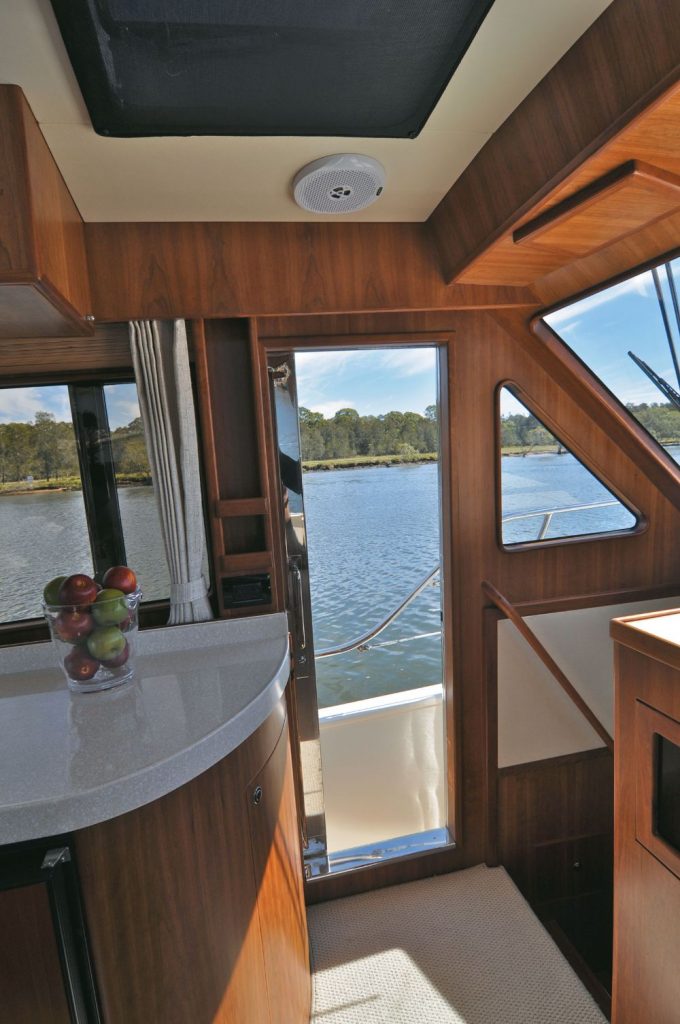
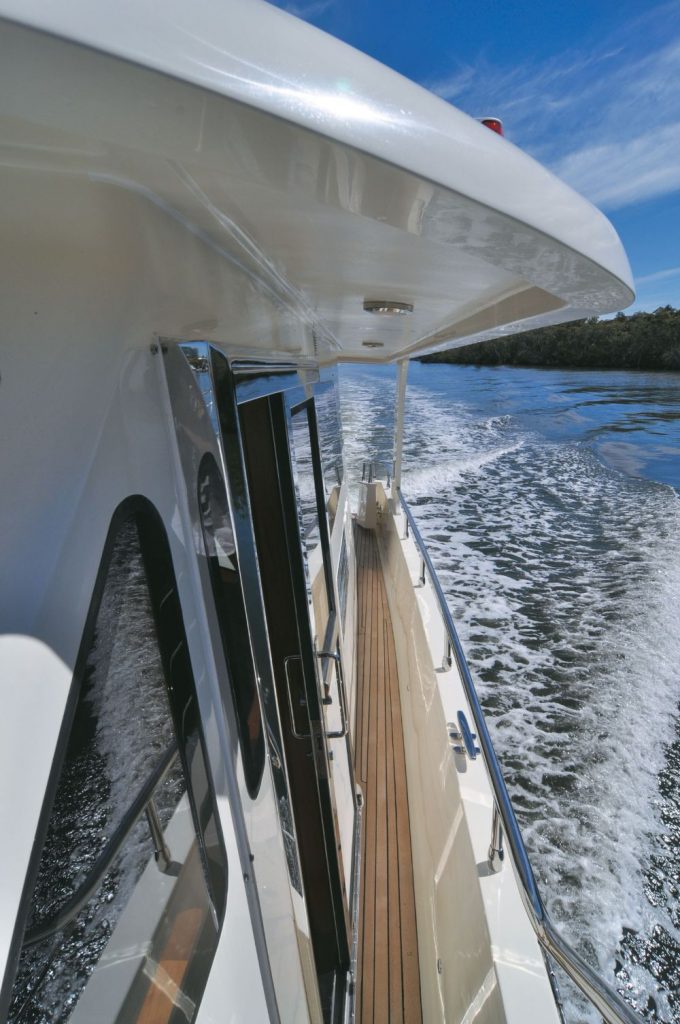
There’s a small sink to port below the hopper window. Beside the sink there’s a second control station with a clear view along the port side for docking. A door beside this and beneath the sink opens to reveal an icemaker.
A solid looking transom door each side of the cockpit allows you to step down onto a boarding deck stretching rightacross the transom and set appropriately for easy entry and exit onto marina pontoons.
Just to run over certain parts of all that again, a lot of thought and experience has obviously gone into the ergonomics of operating, docking, anchoring, and living aboard this boat, whereas some would say that the only thing a boat test can reveal any doubt about is where the TV’s situated…
On the Water
As soon as they were started it took no consultation of the spec sheets to discover there were a pair of Cummins engines below decks – their rumble is distinctive, to say the least.
Trawler style cruisers like this one are often (traditionally) a bit on the lazy side, doing their thing at around 10 knots without fuss and without consuming vast amounts of fuel.
Some would say this is part of their appeal. Checking the fuel curve for the Alaska 46 Sedan reveals that at 10 knots or thereabouts both engines are turning over at 1800 rpm and consuming a total of 41 litres of fuel per hour between them giving a theoretical range of 550 nautical miles from the 2270 litres of fuel the tanks contain.
As soon as they were started it took no consultation of the spec sheets to discover there were a pair of Cummins engines below decks – their rumble is distinctive, to say the least.
Trawler style cruisers like this one are often (traditionally) a bit on the lazy side, doing their thing at around 10 knots without fuss and without consuming vast amounts of fuel.
Some would say this is part of their appeal. Checking the fuel curve for the Alaska 46 Sedan reveals that at 10 knots or thereabouts both engines are turning over at 1800 rpm and consuming a total of 41 litres of fuel per hour between them giving a theoretical range of 550 nautical miles from the 2270 litres of fuel the tanks contain.
Adjust the (standard Bennett) trim tabs down and open the throttles and a surprise awaits. The 16 tonne displacement hull gets up and boogies with surprising alacrity.
We saw 23 and then reached 24 knots on the GPS by fiddling around with the tabs to optimise high speed trim. This boat had been in the water awhile, too. Leigh-Smith staffers recorded over 25 knots during sea trials when the first Gen II model powered by the 480hp QSB engines arrived. What’s more important around crowded waterways populated by people fishing from tinnies anchored mid channel, the hull rose onto the plane (with appropriate use of the tabs) with minimal bow lift, maintaining an excellent view of the water immediately ahead. Manoeuvring at planing speeds showed the Alaska to be quite nimble, too.
Back in the marina we were even happier to leave the driving to our friendly Leigh- Smith salesperson when the final test of the boat’s manoeuvrability came with a berth tucked way back in a corner after negotiating an awkward angle between two other boats with less than a metre clearance either side. It would have tested any skipper’s resolve and proved an able demonstration of just how effective the S/P SE100 bow and stern thrusters are – and probably why they’re now included on the standard inventory.
The Generation II Alaska 46 Sedan is clearly an all-round refinement of a boat that was a pretty darn fine rendition of the trawler style cruiser theme to start with.
TECHNICAL SPECIFICATIONS
- Design Name: Alaska 46 Sedan Gen ll
- Builder: DHS
- Country of Origin: Shanghai China
- Designer: DHS
- Interior Designers: Identity Marine Interiors
- Year Launched: 2012
- LOA: 15.1m
- LOH: 14m
- Beam: 4.25m
- Draft: 1.07m
- Displacement: 16,000kg
- Max Speed: 25Knts
- Cruise Speed: 18Knts
- Fuel Cap: 2270Lts
- Water Cap: 756Lts
- Construction: Fibreglass
- Classification: RINA
- Engines Make: Cummins QSB 5.9L 480
- Gearboxes: ZF Marine Arco
- Drive Train: Shaft
- Propellers: Four blade NI-AL bronze
- Generator: Onan 7KVA
- Inverter/Charger: Vitron 3000
- Battery Charger: Xantrax
- Air Conditioning: Marine Air
- Bow Thruster: Sidepower
- Stern Thruster: Sidepower
- Trim Tabs: Bennett
- Lighting: LED 12v
- Anchor Winch: Muir Dual Capstan Cheetah
- Anchors: 60lb S/S Plough
- Engine Controls: Cummins
- Paint (Antifouling): International coppercoat
- Deck Hatches: Mainship S/S
- Heads: Tecma Electric toilets
- Wood Finish: Satin timber finish
- Upholstery: Macro-Suede
- Ent Sys: Samsung & Fusion
ELECTRONICS
- GPS/Plotter: Simrad NSS12
- Depth Sounder: Simrad NSS12
- VHF: Icon
- Switch Panel: BEP C Zone
- Base Price: $Aus790,000
- Price As Tested: $Aus835,000




